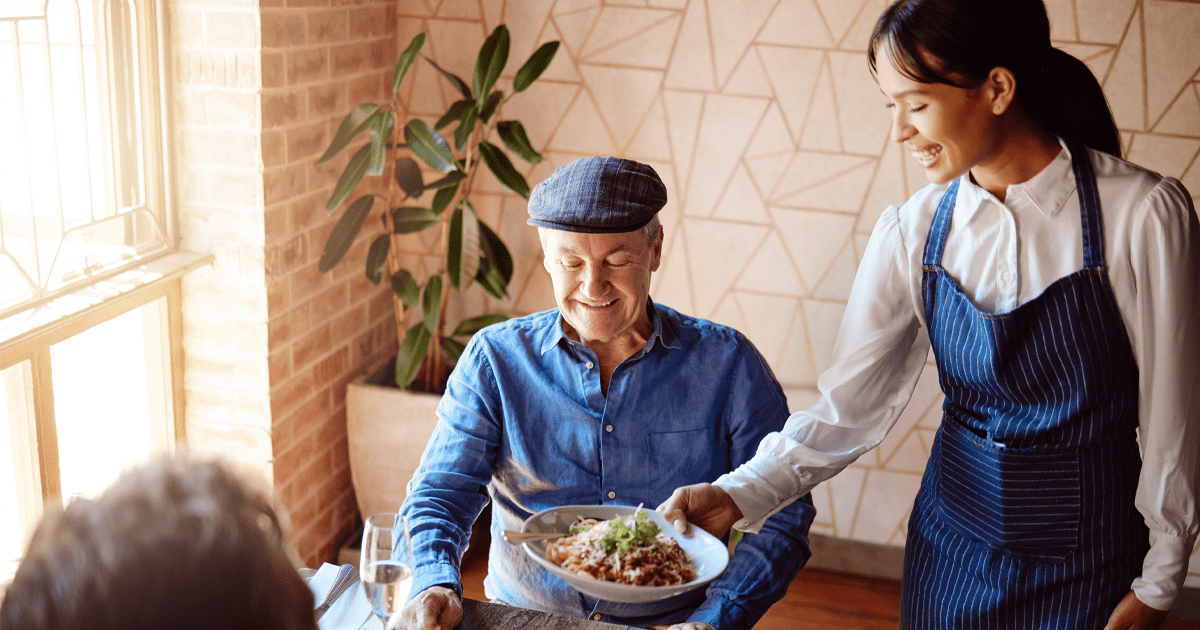November is Long-Term Care Awareness Month. With 70% of older adults (65+) requiring long-term care as they age, the need for senior living communities is only growing with time. If you have a loved one in this age group or need care sooner rather than later, you’re likely ready to start looking at communities in your area. It’s important to remember that a community’s philosophy should revolve around curating programs and living experiences designed to prioritize resident happiness and satisfaction with this statistic in mind.
However, ensuring your loved one is comfortable in their new home involves evaluating more than how staff structure the living space; it encompasses addressing the entirety of a senior’s lifestyle. Dining is central to the aging experience because it serves as a cornerstone for social interaction, nutrition, and sensory enjoyment.
Because of this, you want to find a long-term community excited to create the best environment possible for their loved ones to enjoy – which involves offering holistic approaches to care that support their multifaceted needs, including nutrition. This is what National Long-Term Care Awareness Month is all about.
At Culinary Services Group, we know that bringing awareness to supporting healthy long-term care options doesn’t stop on November 31st. Helping senior living communities achieve culinary excellence all year is our priority and our passion. If you’re searching for care for a loved one this November, start National Long-Term Care Awareness Month by reading this short guide to know what to look for in a long-term care dining program.
Assessing A Dining Program
Regularly evaluating a dining program is vital to maintaining a safe, clean, and enjoyable experience for residents, so don’t be afraid to ask questions about this as you’re touring somewhere. The saying “If it’s not broke, don’t fix it” doesn’t always apply to mealtimes. Having a structured and sterile environment provides consistency during mealtimes, which can benefit some older adults with cognitive impairments, but it doesn’t necessarily always contribute toward an overall more positive culinary experience.
Think about what features your loved one is used to that may benefit residents and do a quick assessment by asking yourself a few questions like:
- Can residents sit where they want while they’re eating?
- Are family and friends welcome to join mealtimes?
- Do residents have options at each meal?
- Does your community offer restaurant-style dining?
If the answer to any of those questions is no, it’s a sign that it may be time to find a community that offers more resident-friendly decisions as part of its food service management program.
Why Person-Centered Dining Works
Traditionally, senior care has been focused on cost-effective, efficient, and convenient ways to provide the best care possible while reducing the burden on staff. Unfortunately, a medical model can potentially deprioritize the needs of residents instead of contributing toward a more senior-centric operational mindset.
Person-centered dining helps your community navigate away from best practices that may negatively contribute to your residents’ well-being because it humanizes the dining experience. The following things are factors that make up person-centered care and should be a part of how long-term care communities create a personalized dining experience for their residents:
- Comfort, compassion, and empathy
- Family involvement
- Respecting resident preferences
- Nutrition education
- Emotional support and physical comfort
- Attending to individual medical needs
The Center for Medicare and Medicaid Services (CMS) also bases its safety and health guidelines on person-centered care, so that’s how you know it works. Here are a few ways some long-term care communities are utilizing person-centered dining in their communities.
Featuring Liberalized Diets
Liberalized diets focus on resident preferences that align with their medical needs, making it easier for long-term care dietitians to customize a meal plan. Regardless of whether your loved one has a condition that makes it more difficult to eat, needs a low-salt or low-fat diet, or is just a picky eater, there are ways to ensure they can have delicious and nutritious food.
Another part of why liberalized diets are a positive part of a dining program is that they offer a more diverse range of foods, including culturally relevant dishes and resident favorites, which promotes autonomy and a sense of belonging for residents.
Making Food Accessible 24/7
Does your loved one graze on food throughout the day rather than eating three large meals? This is common, so don’t worry about this as you evaluate dining programs. Research shows that older adults eat less as they age, so incorporating 24/7 food accessibility is integral to a meal structure.
Enhancing the Ambiance
Eating in a group setting can be intimidating, no matter how young or old you are. Playing relaxing music, using fun-colored smallware (i.e., plates, cups, cutlery), and presenting food in new and exciting ways are all things that help make mealtimes something to look forward to rather than a chore. Plus, the more comfortable a dining area’s ambiance is, the easier it is to transition from independent living to assisted living care.
Encourage Resident Participation
Person-centered dining isn’t only a strategy used by long-term care staff. It’s also important that residents participate and provide feedback so that staff know whether their efforts to improve the culinary experience are working. Look for indicators like readily available feedback forms and “town hall” style meetings where residents can discuss concerns and learn about new initiatives as they’re touring a community.
Is Your Loved One Making the Transition to Long-Term Care?
Making the transition to long-term care isn’t always easy. It can be a stressful and emotional time for older adults and their families. That’s why evaluating a dining program is so important; it helps ensure your loved one can enjoy a meal just like they would at home. We hope this guide serves as a valuable resource during National Long-Term Care Awareness Month in helping you discover a community that prioritizes person-centered dining and provides a variety of dining amenities and services to enhance your loved one’s overall well-being.








